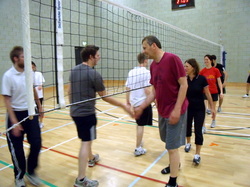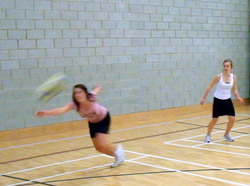About volleyball
A great sport for your friends and family to dive into is volleyball, so let's discuss how to play volleyball for beginners.
Volleyball is relatively easy to learn, does not require expensive equipment, and can be enjoyed by people of almost any age. Perhaps that's why, according to the International Volleyball Federation (FIVB), 1 in 6 people worldwide either plays or watches volleyball. Volleyball can be played indoors or outdoors (beach volleyball, grass).
Volleyball is a complex game of simple skills. When first learning how to play volleyball, you need to understand the object of the game which is to beat your opponents to a predetermined number of points. Today, rally scoring is primarily used which means a point is scored as a result of each play. Most volleyball games today are rally scoring and played to 25 points.
|
Indoor volleyball is played with two 6 player teams. Each team has 3 front row players and 3 back row players. The front row players mainly hit and block. The back row players mainly pass and dig. Social volleyball matches can be played by any number of people at any size court.
To score a point in volleyball, a team must win a rally. A rally is begun by a server serving the ball into play. The ball is served over the net to the opposing team. You get a point when the opposing team is unable to successfully pass the ball back over the net within bounds.
|
Techniques
The basic skills for playing volleyball are serving, setting, attacking, blocking and digging.
The serve is what begins the game and has to be direct one hand hit from behind the base line over the net and to the opponents’ side.
Setting is the action of playing the ball to a teammate. Setting is usually done in an overhead motion using the hands. Players that have a hard time getting in good position to hand set may elect to set using a forearm passing motion. This is called bump setting.
Attacking or spiking is the action of sending the ball over the net to the opponent's court. Attacks are usually done by taking steps to approach the net to jump and hit the ball. The volleyball approach and hit is often thought of as the most fun skill in volleyball.
A block is the action of trying to prevent the ball from crossing the net into your court.
Digging is the action of playing the ball in a way that prevents the ball from touching the court after an attack by the opponents.
To get good at these volleyball skills require improving physical proficiency and hand-arm-and-eye coordination. Being able to effectively communicate with your teammates and having an understanding of how to play volleyball will highly influence how well you perform these skills.
Keep it simple when you play with beginners, and have fun!
The rules below have been copied from the FiVB website's Basic Rules page.
|
Volleyball is a sport played by two teams on a playing court divided by a net. There are different versions available for specific circumstances in order to offer the versatility of the game to everyone. The object of the game is to send the ball over the net in order to ground it on the opponent's court, and to prevent the same effort by the opponent. The team has three hits for returning the ball (in addition to the block contact). The ball is put in play with a service, hit by the server over the net to the opponents. The rally continues until the ball is grounded on the playing court, goes "out" or a team fails to return it properly. In Volleyball, the team winning a rally scores a point (Rally Point System). When the receiving team wins a rally, it gains a point and the right to serve, and its players rotate one position clockwise.
Volleyball is a complex game of simple skills. A purely rebound sport (you can't hold the ball), volleyball is a game of constant motion.
|
A team can touch the ball three times on its side of the net. The usual pattern is a dig (an underarm pass made with the forearms), a set (an overhead pass made with the hands) and a spike (the overhead attacking shot). The ball is served into play. Teams can also try to block the opponent's spike as it crosses the net. A block into your own court counts as one of your three touches in beach volleyball, but not in volleyball.
Power and height have become vital components of international teams, but the ability of teams and coaches to devise new strategies, tactics and skills has been crucial for continued success.
- There are six players on court in a volleyball team, who each must rotate one position clockwise every time their team wins back service from the opposition. Only the three players at the net positions can jump and spike or block near the net. The backcourt players can only hit the ball over the net if they jump from behind the attack line, also known as the three-metre line, which separates the front and back part of the court.
- Volleyball has developed into a very specialised sport. Most teams will include in their starting line-up a setter, two centre blockers, two receiver-hitters and a universal spiker. Only certain players will be involved with service reception. Players will also have specialist positions for attack and defence. Substitutions are allowed during the game.
- From 1998, volleyball used a new scoring system. Teams scored a point on every rally (rally point system), regardless of which team served. Formerly, a team could only win a point if it served the ball. Winning the serve back from the opposition was known as a side-out.
- Matches are played best of five sets. The first four sets are played to 25 points, with the final set being played to 15 points. A team must win a set by two points. There is no ceiling, so a set continues until one of the teams gains a two-point advantage. Previously, all sets were to 15 points, with the first four sets having a ceiling of 17 and the final set requiring at least a two-point winning advantage.
- From 1996, the FIVB introduced a new specialist role: the libero. This player wears a different coloured uniform from the rest of the team and can be substituted in backcourt for any player on the team. The libero cannot serve, spike the ball over the net or rotate into the front-line positions, but plays a vital role for the team in serve reception and backcourt defence. There must be at least one point played between a libero substituting off for a player and going back on the court for another player – hence he/she cannot be on the court for the whole game. The libero has added an extra dimension to backcourt defence, improving the reception of teams, lengthening the rallies and giving a vital role to shorter players.




